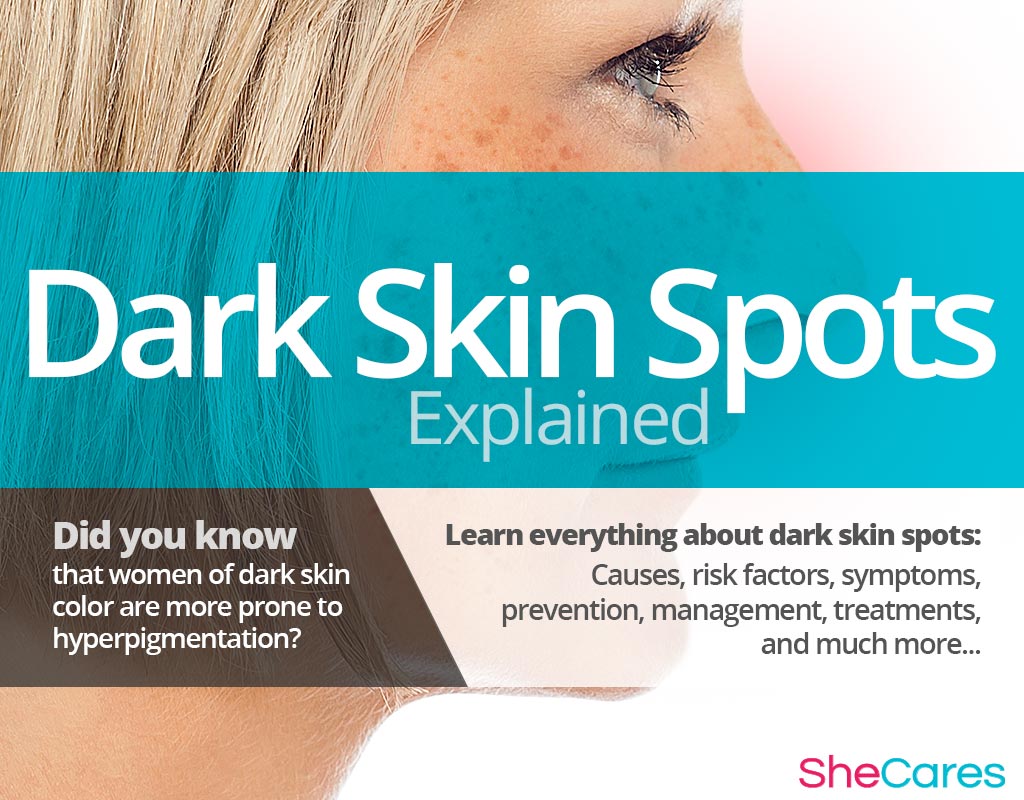About
Quick Facts about Dark Skin Spots
- Sun exposure is a major risk factor for hyperpigmentation at all ages.
- Women of dark skin color are more prone to hyperpigmentation.
- Dark skin spots that occur as a result of acne are called post-inflammatory hyperpigmentation.
Dark skin spots - or hyperpigmentation - are related to the increased or uncontrolled production of melanin, the most abundant skin pigment. Hormones regulate the activity of melanocytes, or the cells responsible for producing said pigment.
Significant hormonal fluctuations occur during certain stages of reproductive life - namely puberty, pregnancy, postpartum (including breastfeeding), and menopause. The dark spots that appear during each reproductive stage vary depending on the type of hormonal imbalance, the individual's own melanocytes, and other factors, including environmental.
Types of Dark Skin Spots
There are several ways in which dark skin spots present themselves on the female body, each type having different causes and treatment options.
- Acanthosis nigricans. These patches appear under the armpits, on the neck, and on other skin folds. They are velvety, sometimes thick, and uniformly cover the affected area. This disorder almost always indicates a more serious underlying disease, such as type II diabetes or polycystic ovary syndrome (PCOS), which are both hormonal disorders. Click on the link to learn more about brown and velvety skin patches.
- Age spots. Also known as liver spots or solar lentigines, age spots are brown spots on the skin that vary in size, usually appearing on areas that have received most sun exposure, such as the face, hands, shoulders, and arms. They are more common in those over the age of 50. They do not need treatment, yet can be effectively managed for aesthetic reasons.
- Melasma. Skin hyperpigmentation from melasma is largely due to excessive sun exposure or as a result of hormonal changes, especially during pregnancy, during which it is called the “mask of pregnancy.” It most commonly concentrated on the face, appearing as brown or gray-brown patches. Although not inherently dangerous for one's health, women with melasma may wish to take action to clear up their complexion. Read more about melasma by clicking on the previous link.
- Post-inflammatory hyperpigmentation. These dark skin spots usually appear on the face or neck after an inflammatory skin condition, such as acne. They are also not malignant, yet can be aesthetically displeasing, leading many women to look for effective management techniques to get rid of the hyperpigmentation.
To better understand the various causes behind dark spots on the skin, continue reading the next section.
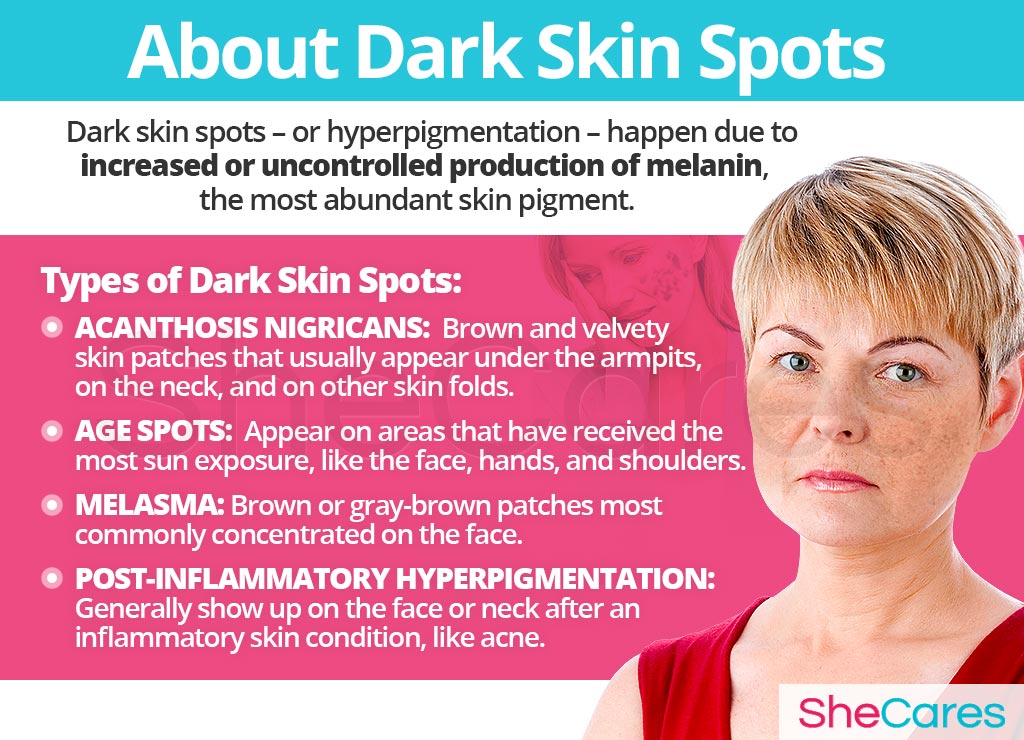
Causes
Understanding the causes behind various types of dark skin spots is essential for knowing how to appropriately manage and treat them as necessary. In most cases of dark spots on the skin that women experience, a major cause is hormonal change or imbalance. In addition to hormonal causes, there are other factors that may provoke or aggravate them.
Read further to learn more about both the hormonal and additional causes of dark skin spots.
Hormonal Causes of Dark Skin Spots
The endocrine system, or the group of glands and organs that produce hormones, experiences natural changes in the different stages of a woman's reproductive life. The resulting hormonal imbalances can have negative effects on all parts of the body, including the skin.
A hormonal imbalance of estrogen and progesterone - the chief female sex hormones - can trigger melanocytes (pigment-making cells in the skin) to produce additional pigment, or melanin, which can give rise to dark spots or patches on the skin. Because one function of estrogen is regulating melanocytes, changes in its levels can have a profound effect on the amount of melanin produced. Similarly, other types of hormonal imbalances can also result in skin hyperpigmentation as a change in the production of melanin occurs.
Typical cases of dark skin spots experienced throughout a woman's life are the result of natural hormonal changes during the reproductive stages: puberty, pregnancy, post-partum, and menopause.
Puberty brings the first hormonal changes and imbalances in a young woman's life. These natural fluctuations, such as those behind acne, can cause dark skin spots.
Pregnancy also brings great changes in hormone levels in order for the body to support fetal development. Sudden dark patches on the skin are most common during this time of hormonal flux.
Postpartum and breastfeeding is another stage in which hormones are changing constantly. This can lead to a continuation of the dark skin patches that appeared during pregnancy.
Menopause refers to the stage in a woman's life in which hormone levels naturally decline as her fertile period comes to a close. The hormonal imbalances can cause skin hyperpigmentation, especially if a woman has had strong sun exposure throughout her lifetime.
Other Causes of Melasma
While hormonal fluctuations are a primary cause of the types of dark skin spots that women most commonly experience, some blemishes have other causes, such as the use of some medications and strong sun exposure.
Continue reading to learn about certain risk factors and external triggers that can make a woman more prone to having skin discoloration.
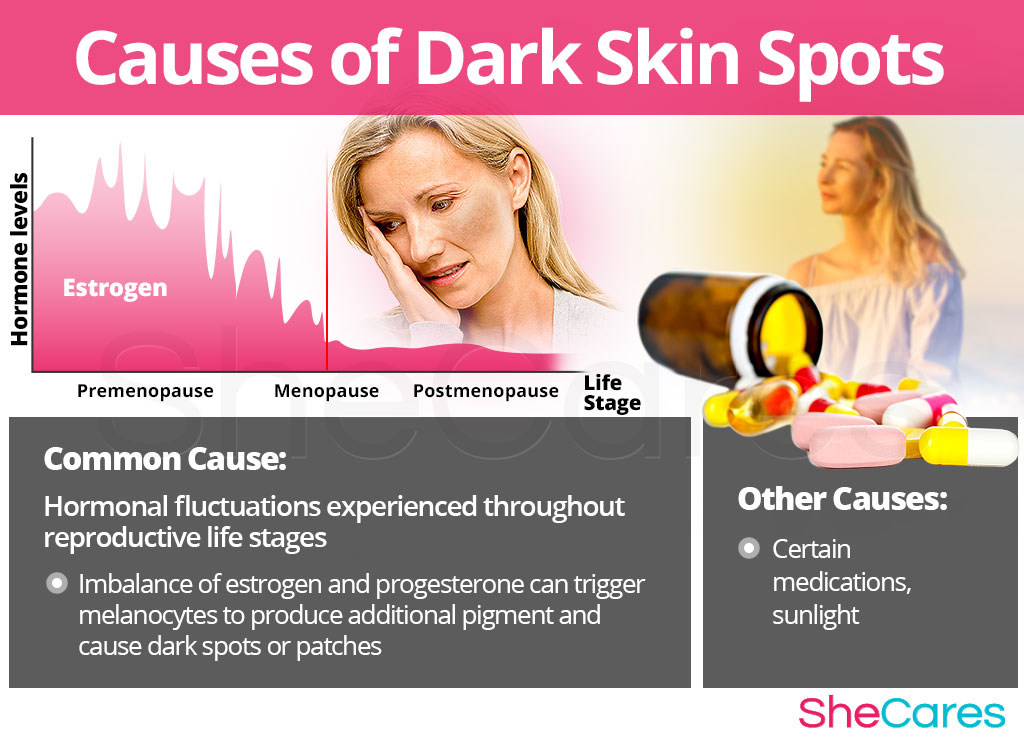
Risk Factors and Triggers
Risk Factors for Dark Skin Spots
Some women are more likely to develop dark brown spots on the skin than others because of certain health and personal reasons, such as obesity and genetics.
- Skin tone. Women of Indian, African, Hispanic, Middle Eastern, or Mediterranean descent are more susceptible to melasma because the melanocytes in darker skin tones are already more active.
- Family history. Those with a family history of melasma are also more likely to develop this type of dark skin patches.
- Lifetime sun exposure. The sun's ultraviolet rays can cause the skin to produce additional melanocytes in heavily-exposed areas of the skin. If these melanocytes are later triggered to produce more melanin, such as during a time of hormonal imbalance, it is likely that dark spots will emerge.
- Pharmaceutical hormone treatments. Women receiving hormones - through hormone replacement therapy (HRT), oral contraceptives, or human growth hormone replacement - are more likely to develop hyperpigmentation, like melasma, because of the fluctuating hormone levels. Also, if a woman has had melasma in the past specifically because of hormone treatments, she is likely to develop melasma again if those treatments are resumed.
Triggers of Dark Skin Spots
In addition to long-term risk factors, dark skin spots can flare up suddenly because of certain triggers. Avoiding contact with these triggers - namely certain products - as much as possible will reduce the incidence or recurrence of dark patches on the skin.
- Skin care products. Some lotions, soaps, and creams can aggravate the skin, increasing the production of pigment, and therefore causing the emergence of dark spots.
Keep reading to find out more about the signs and symptoms of hyperpigmentation in order to choose a treatment specific to its cause.
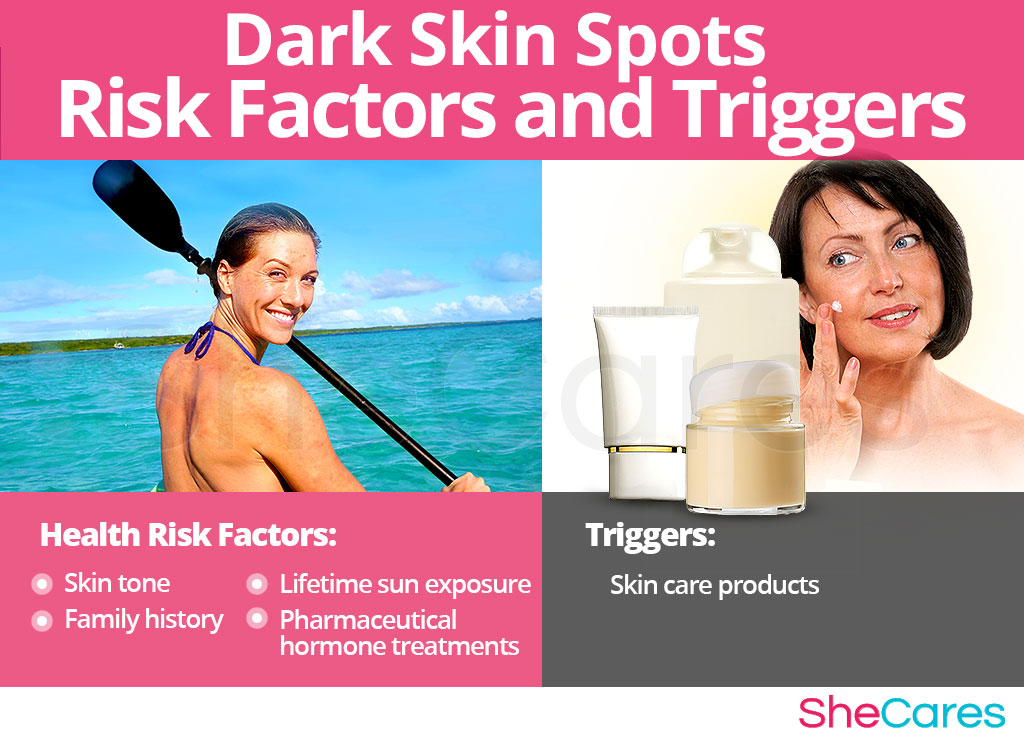
Signs and Symptoms
The hormonal fluctuations in the female body will affect each individual woman differently throughout the course of her reproductive life. Women who do develop dark skin spots will find different types on different areas of their skin. However, there are some common symptoms that the majority of women have.
Common Symptoms of Melasma
- Flat, oval areas of increased pigmentation (age spots)
- Tan, brown, or dark skin discolorations after excessive sun exposure (melasma)
- Patches or spots that appear after inflammatory skin condition (post-inflammatory hyperpigmentation)
- Unfamiliar patches or spots on the face, neck, or upper body
- Patches or spots often symmetrical when occurring on the face
Diagnosis of Dark Skin Spots on the Face
To diagnose and identify the symptoms of darkened skin, a dermatologist typically performs nothing more than a simple skin exam. In some less common cases, they may also run some tests, especially if an underlying hormonal condition is the suspected cause.
Complications of Dark Skin Spots on the Face
Many dark skin spots are not associated with any health complications and are not a sign of cancer. Nonetheless, a woman may be concerned about the way the spots affect their appearance, especially if they emerge on the face and neck. This can lead to lower self-esteem.
Women who have large or embarrassing spots may wish to learn how to treat or prevent more of them. Continue reading to find some useful prevention methods and management techniques that may help with hyperpigmentation.
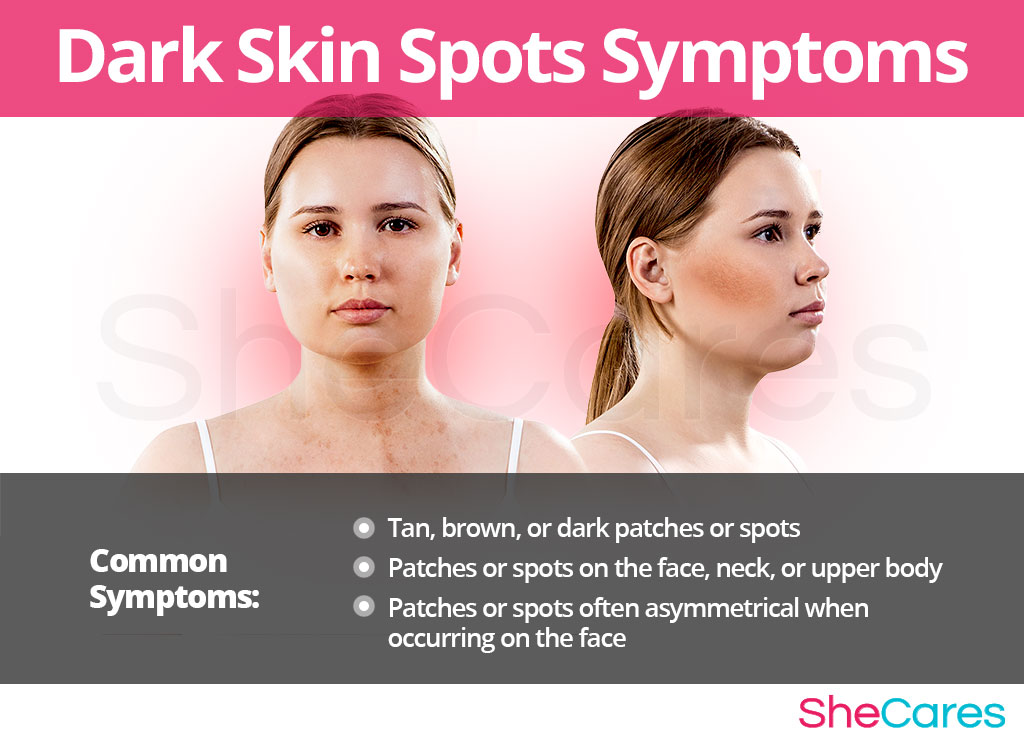
Prevention and Management
Preventing Melasma
There is no single, surefire way to fully prevent dark skin spots, since there is no way to hold back the body's natural hormonal processes. However, there are some steps a woman can take to reduce the chances of developing dark skin patches or to minimize their appearance.
An important means of prevention is lifestyle changes, especially concerning diet, exercise, and healthy habits. Additionally, lifestyle adjustments can be complemented with supplements that help enhance the endocrine system and thus prevent or lessen hormonal imbalances.
In some cases, prevention may not be possible. If dark skin patches have already appeared, there are some management techniques that can help to reduce the intensity of the hyperpigmentation. Continue reading to learn more about the various ways that the spots can be managed or lessened.
Managing Dark Skin Spots
Dark skin spots are usually benign, meaning they do not present any immediate health concern. However, because women may find hyperpigmentation embarrassing, they may wish to manage or mask dark spots once they have emerged. Makeup can be applied directly to skin to lessen the appearance of dark areas.
Read on to learn more about the various treatments for dark skin spots and which may be most suitable based on their underlying cause.
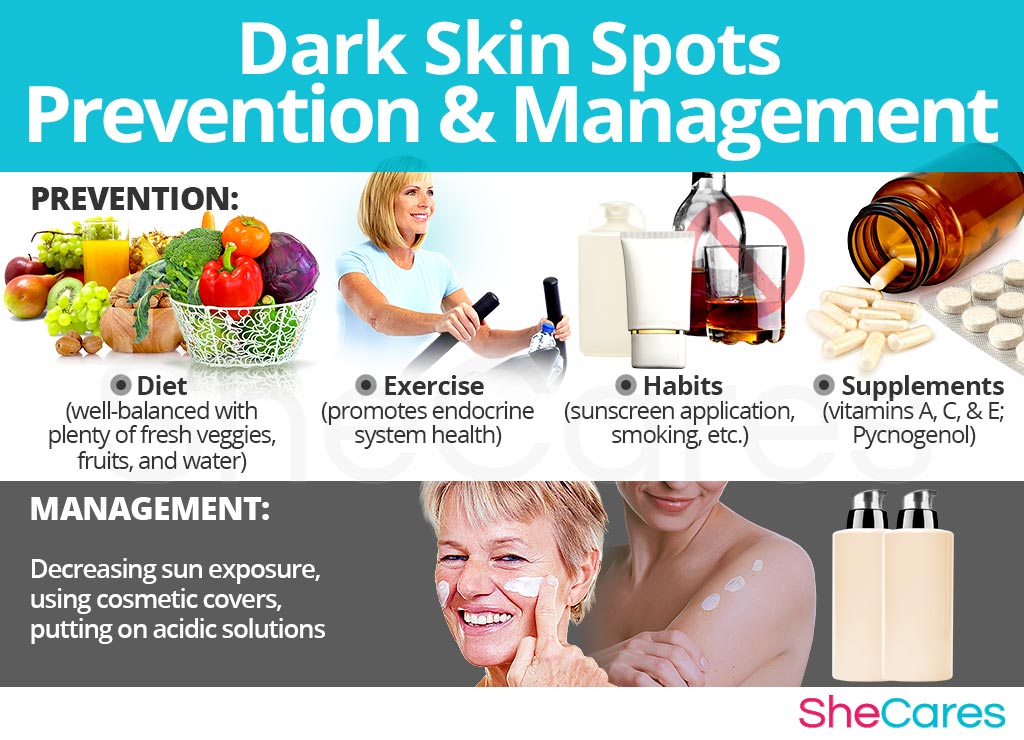
Treatments
There are many possible treatments for hyperpigmentation. The most effective treatment depends on both the underlying cause - usually some form of hormonal imbalance - as well as the individual woman's lifestyle.
Three Approaches to Treat Dark Skin Spots
Three levels can be considered for treating dark skin spots. These are categorized as: (1) Lifestyle Changes, (2) Alternative Medicine, and (3) Pharmaceutical and Surgical Options.
Women are recommended to start with the least risky approach to get rid of hyperpigmentation - lifestyle changes - before proceeding to the next level of treatment. Medical intervention is not usually needed to treat them since they usually have no health ramifications. However, women who wish to remove them and are unable to do so through lifestyle adjustments and alternative medicine may consider pharmaceutical options, after properly assessing the risks related to those treatments.
Lifestyle Changes
The first level of treatment involves the least amount of risk, but it entails the highest amount of self-discipline. In many cases, simple lifestyle changes can lead to healthier skin and the fading of dark skin spots. Generally, a good diet and healthy habits for the skin can help in treating this condition.
As previously mentioned with preventing dark skin spots, it is important to choose fruits and vegetables high in vitamins A, C, and E; quit harmful addictions that could be aggravating the condition, such as smoking; and make sure to always apply sunscreen. Also, regular exercise of at least 30 minutes a day, five days a week should be performed in order to relieve stress, increase blood flow, and nourish skin cells.
Though these lifestyle changes may help reduce or eliminate the appearance of dark skin patches, they do not treat the hormonal imbalance that commonly lies behind their emergence. Therefore, further treatment may be necessary. Alternative medicines have proven to be a tremendous way of treating dark skin spots related to hormonal fluctuations in the body safely and naturally.
Alternative Medicine
Alternative medicine and supplements often involve little to no risk and can be a very effective means of treating dark skin spots that have hormonal imbalance at the root of their cause. In terms of herbal supplements, there are two main kinds that can be used: phytoestrogenic and hormone-regulating supplements.
Phytoestrogenic herbal supplements
These supplements - such as black cohosh - contain estrogens produced by plants, which function as a complement or replacement for estrogen in a woman's body. The introduction of these plant hormones resolves an estrogen imbalance that could be contributing to the appearance of dark skin spots.
Nevertheless, because they contain strong concentrations of exogenous estrogen hormones, they are not safe for all women, especially those in pregnancy. They should be used short-term by others. In all cases, work with a certified herbalist, and closely monitor results.
Hormone-regulating herbal supplements
These supplements, including Macafem, stimulate natural hormone production by supporting the endocrine glands, which, in turn, helps the body produce hormones more efficiently and at the right levels. This results in a balance of all hormones in the body, not just estrogen.
This type of supplement is considered a safer and more natural way of treating a hormonal imbalance that can be behind the appearance of dark skin spots. In addition, they can be used throughout a women's life, except during pregnancy.
There are some other kinds of supplements that can also eliminate the appearance of dark skin patches or at least lighten them, including vitamins and other herbal supplements.
A combination of these two approaches - lifestyle changes along with alternative medicine - is likely to be the most effective way of reducing the appearance of dark skin spots. However, sometimes the symptoms will be so severe or persistent that more drastic treatment becomes necessary.
Pharmaceutical Options
Treatment at the third level involves the highest risk and is often the costliest. Not all treatments are appropriate for women at a given life stage. Therefore, it is highly recommended to consult a licensed medical professional before starting any pharmaceutical treatments for dark skin spots. In addition, some may require a doctor's prescription.
The majority of pharmaceutical options are topical medications. Dark skin spots can be tough to treat, resistant to treatments, and take a long time to show results. Moreover, very few of those treatments address the underlying hormonal imbalance.
These three approaches to treatment - lifestyle changes, alternative medicine, and pharmaceutical options - are not mutually exclusive. A woman may choose to employ different approaches at different times or a combination thereof, depending on the severity and duration of the dark skin spots. Many women find that their symptoms are best alleviated through a combination of healthy lifestyle and alternative medicine treatments.
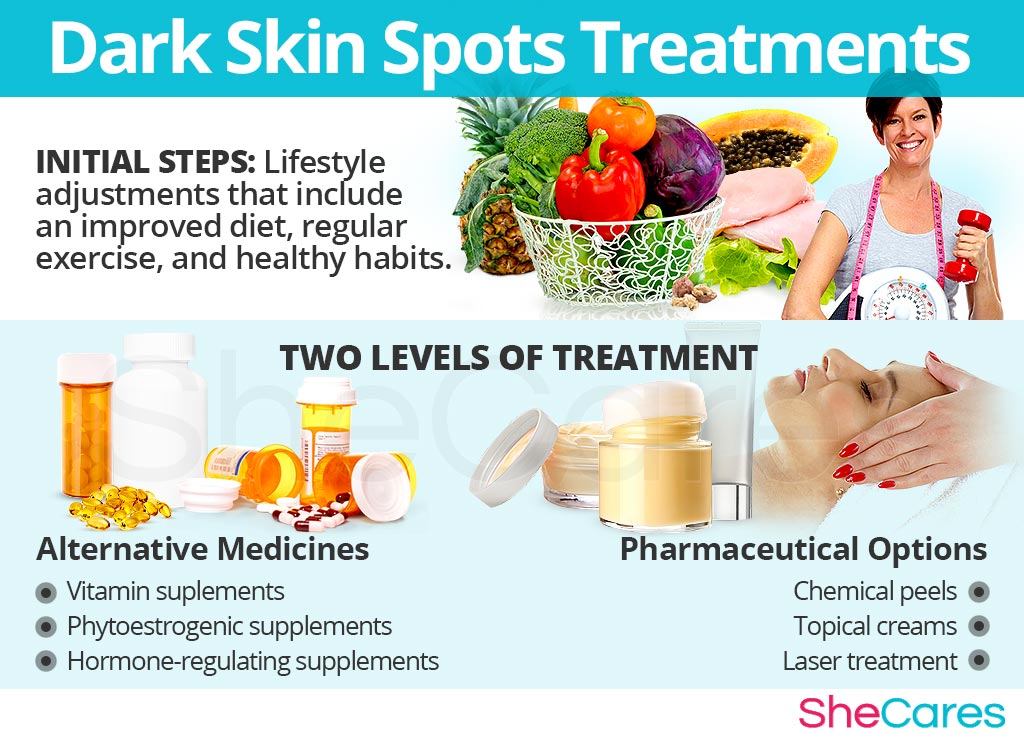
Sources
- American Academy of Dermatology. (n.d.). How to fade dark spots in skin of color | Caring for your skin in menopause. Retrieved September 6, 2019, from https://www.aad.org/public/skin-hair-nails/skin-care/skin-of-color | https://www.aad.org/public/skin-hair-nails/skin-care/skin-care-during-menopause
- American Osteopathic College of Dermatology. (n.d.). Hyperpigmentation. Retrieved September 6, 2019, from https://www.aocd.org/page/Hyperpigmentation
- Davis, E.C. & Callender, V.D. (2010). Postinflammatory Hyperpigmentation: A Review of the Epidemiology, Clinical Features, and Treatment Options in Skin of Color. The Journal of Clinical and Aesthetic Dermatology, 3(7), 20-31. Retrieved September 6, 2019, from https://www.ncbi.nlm.nih.gov/pmc/articles/PMC2921758/
- Gui, M. et al. (2017). Instrumental Evaluation of the Depigmenting Efficacy of an Oral Supplementation Containing Peptides and Chrysanthemum Extract for the Treatment of Melasma. Cosmetics 2017, 4(4), 42. doi: 10.3390/cosmetics4040042
- Mayo Clinic. (2018). Age spots (liver spots): Symptoms & causes. Retrieved September 6, 2019, from https://www.mayoclinic.org/diseases-conditions/age-spots/symptoms-causes/syc-20355859
- MedlinePlus. (2019). Patchy skin color. Retrieved September 6, 2019, from https://medlineplus.gov/ency/article/003224.htm
- Natale, C.A. et al. (2016). Sex steroids regulate skin pigmentation through nonclassical membrane-bound receptors. eLife, 5, e15104. doi: 10.7554/eLife.15104
- Oregon State University. (2012). Vitamin A and Skin Health. Retrieved September 6, 2019, from https://lpi.oregonstate.edu/mic/health-disease/skin-health/vitamin-A
- Phelps, K. & Hassed, C. (2011). Skin: General Practice: The Integrative Approach Series. Australia: Elsevier. Available from Google Books.
- Stevenson, S. & Thornton, J. (2007). Effect of estrogens on skin aging and the potential role of SERMs. Clinical Interventions in Aging, 2(3), 283-297. Retrieved September 6, 2019, from https://www.ncbi.nlm.nih.gov/pmc/articles/PMC2685269/
- University of Wisconsin Health. (n.d.). The Benefits of Drinking Water for Your Skin. Retrieved September 6, 2019, from https://www.uwhealth.org/madison-plastic-surgery/the-benefits-of-drinking-water-for-your-skin/26334
Footnotes:
- Genetics Home Reference. (2018). McCune-Albright syndrome. Retrieved September 6, 2019, from https://ghr.nlm.nih.gov/condition/mccune-albright-syndrome
- Kumar, P. & Magon, N. (2012). Hormones in pregnancy. Nigerian Medical Journal, 53(4), 179-183. doi: 10.4103/0300-1652.107549
- Roh, J. (2018). Linea nigra. Retrieved September 6, 2019, from https://www.dermnetnz.org/topics/linea-nigra/
- Harvard Health Publishing. (2018). Unmasking the causes and treatments of melasma. Retrieved September 6, 2019, from https://www.health.harvard.edu/womens-health/unmasking-the-causes-and-treatments-of-melasma
- Dereure, O. (2001). Drug-induced skin pigmentation. Epidemiology, diagnosis and treatment. American Journal of Clinical Dermatology, 2(4), 253-262. doi: 10.2165/00128071-200102040-00006
- Nakamura, M. et al. (2013). Tobacco smoke-induced skin pigmentation is mediated by the aryl hydrocarbon receptor. Experimental Dermatology, 22(8), 556-558. doi: 10.1111/exd.12170
- Grether-Bech, S. et al. (2015). French Maritime Pine Bark Extract (Pycnogenol®) Effects on Human Skin: Clinical and Molecular Evidence. Skin Pharmacology and Physiology, 29(1), 13-17. doi: 10.1159/000441039
